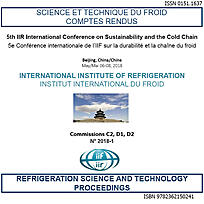
Document IIF
Protection des planchers en T dans les conteneurs frigorifiques intermodaux.
T-bar floor protection in intermodal refrigerated containers.
Numéro : pap. 60
Auteurs : LAWTON A. R., RHODES C.
Résumé
Intermodal refrigerated containers have extruded aluminium T-bar floors to facilitate air circulation required for maintaining cargo temperature. Whilst the primary design of such containers is to maintain temperature typically over periods of a few weeks, as a cargo is taken from the point of origin to the seller, it is found that many alternative uses are employed by companies across the globe. In some regions containers are used as short-term storage which sees them subjected to loading and unloading many more times than an average container. Under these conditions, T-bar floor failure is not uncommon and is prohibitively expensive to
repair. Adding a cheap protecting material which can be replaced quickly, cost effectively and which doesn’t impair temperature management when stowed is regarded as the best solution. Data is presented on plywood protection fitted to two standard ISO 1AAA (12.2m insulated) container refrigeration systems. Comparison is made with two standard systems showing how the modification affects the operation of the refrigeration system and its ability to cool a warm-loaded cargo and then maintain
temperature.
Documents disponibles
Format PDF
Pages : 6
Disponible
Prix public
20 €
Prix membre*
Gratuit
* meilleur tarif applicable selon le type d'adhésion (voir le détail des avantages des adhésions individuelles et collectives)
Détails
- Titre original : T-bar floor protection in intermodal refrigerated containers.
- Identifiant de la fiche : 30023414
- Langues : Anglais
- Source : 5th IIR International Conference on Sustainability and the Cold Chain. Proceedings: Beijing, Chine, 6-8 avril 2018
- Date d'édition : 06/04/2018
- DOI : http://dx.doi.org/10.18462/iir.iccc.2018.0060
Liens
Voir d'autres communications du même compte rendu (72)
Voir le compte rendu de la conférence
Indexation
- Thèmes : Conteneurs et emballages
- Mots-clés : Bois; Plancher; Transport intermodal; Transport frigorifique; Banane; Essai; Conteneur frigorifique
-
Low GWP insulation blowing agents and methods o...
- Auteurs : LAWTON R., MYNOTT T., MARSHALL N.
- Date : 16/08/2015
- Langues : Anglais
- Source : Proceedings of the 24th IIR International Congress of Refrigeration: Yokohama, Japan, August 16-22, 2015.
- Formats : PDF
Voir la fiche
-
COMPARAISON DES SYSTEMES DE REFRIGERATION DES G...
- Auteurs : ESTEBAN CASAS F., MORENO DE GUERRA A.
- Date : 03/03/1981
- Langues : Français
- Source : Developments in temperature controlled land transport./ Le développement du transport terrestre à température dirigée.
- Formats : PDF
Voir la fiche
-
Comparison between porthole and integrated reef...
- Auteurs : WILD Y.
- Date : 1997
- Langues : Anglais
- Source : Refrigeration in Sea Transport - Today and in the Future
- Formats : PDF
Voir la fiche
-
THE CONTAINER TRANSPORT OF BANANAS IN THE SOUTH...
- Auteurs : HARRIS S., LOVEGROVE J. R.
- Date : 26/01/1982
- Langues : Anglais
- Source : Refrigeration of perishable products for distant markets.
- Formats : PDF
Voir la fiche
-
Humidity control and fresh air exchange in reef...
- Auteurs : LUKASSE L., LEENTFAAR G.
- Date : 26/08/2020
- Langues : Anglais
- Source : 6th IIR International Conference on Sustainability and the Cold Chain. Proceedings: Nantes, France, August 26-28 2020
- Formats : PDF
Voir la fiche
